- Analysis and research hotspots of ceramic materials in textile application
Ruihang Huang and Xiaoming Yang*
Donghua University, Shanghai, China
This article is an open access article distributed under the terms of the Creative Commons Attribution Non-Commercial License (http://creativecommons.org/licenses/by-nc/4.0) which permits unrestricted non-commercial use, distribution, and reproduction in any medium, provided the original work is properly cited.
From the perspective of scientometrics, comb the development history and research hotspots of the application of ceramics in textiles, the aim is to fully understand the global ceramic textile development direction and provide a credible reference for related researchers in China. By collecting the bibliographic data of 714 papers on ceramic textiles from 1990 to the present in the WoS core database, from the perspective of bibliometrics, analyze the time distribution, space distribution, research organization distribution, and research direction of ceramics in textile applications, then use methods such as subject word clustering, keyword clustering, and emergent word detection, explore the core content of the research on the application of ceramics in textiles, research hotspots, and future development trends. The study found that the research on ceramic textiles is currently in the extension stage, the papers published by Chinese scholars rank first in the world, but the importance is low. The research has gone through three stages, research hotspots include ceramic textile composite performance, preparation technology, heat preservation, composite material preparation, and application, etc, “microstructure”, “refinement” and ‘temperature’ are research hotspots in this field
Keywords: Citespace, textile, ceramics, knowledge graph
Article publication is the most direct manifestation of research results and directions in a field, the number of articles published in a certain research field reflects the research results, the development speed of this field, and the degree of attention of researchers in this field [1]. Since 1990, the number of publications on the application of ceramics in textiles has shown an overall upward trend, according to the number of publications, it can be roughly divided into three stages [2]. During the six years from 1990 to 1996, the number of publications on the application of ceramic materials in textiles was less than 10, at this stage, overall research efforts are not strong, the number of published documents is small, and the research is in the initial stage [3]. From 1996 to 2007, the total number of publications increased significantly compared with the previous period, however, the volume of annual publications is still relatively small, it shows that the application of ceramic materials in textiles at this stage has attracted the attention of researchers [4]. After 2007, the number of documents has increased greatly and rapidly surpassed the total number of publications in the previous 17 years, it shows that the academic circle attaches great importance to this field at this stage [5]. A certain discipline and field have to be developed, thanks to the attention of scientific researchers, however, the demand and promotion behind the country and region are also important factors in the development of this discipline and field. Analysis of the distribution of countries that publish literature in scientific research, it is conducive to scientific research personnel to clarify their development status, learn from field experts in the countries that have advanced in development [6]. Through combing the related literature of ceramic textiles, get the top 10 countries published in the literature [7]. Refer to the corresponding results of the keyword and topic word map, it is found that the main research hotspots of ceramics in textile applications are: The first direction is the performance research of ceramic textiles, specifically including #0 and #2 and #3#6, Wdrychowicz, M. proved through experiments that the thermal insulation effect of ceramic textiles is stronger than that of general textiles [8]. Kumar, A. studied the surface properties of nano-scale ceramics to change textiles through atomic layer deposition [9], Kubiliene, D. Using a simple domino cascade reduction method, make ceramic nanofiber textiles quickly transform from insulation to electrical conduction at room temperature, it broke the cognition that oxide ceramics are considered non-conductive brittle materials [10]. By collecting the bibliographic data of 714 papers on ceramic textiles from 1990 to the present in the Wos core database, from the perspective of bibliometrics, analyze the time distribution, space distribution, research organization distribution, and research direction of ceramics in textile applications, then use methods such as subject word clustering, keyword clustering, and emergent word detection, explore the core content, research hotspots and future development trends of the research on the application of ceramics in textiles. The study found that the research on ceramic textiles is currently in the extension stage, the papers published by Chinese scholars rank first in the world, but their importance is low. The research has gone through three stages, research hotspots include ceramic textile composite performance, preparation technology, heat preservation, composite material preparation, and application, etc “microstructure’, “refinement” and “temperature” are research hotspots in this field.
Data source
In order to ensure the quality of the literature, the data in this article comes from the Web of Science (WOS) core database. Using advanced search methods, the search formula is “(ALL= (textile)) AND TS= (ceramic)”, there is no limit to the publication time of the literature, search in the WOS core database. Data sources include information such as title, author, unit, keywords, abstract, year, cited and citations, etc, in the end, a total of 1153 valid documents were obtained [11].
Research methods and tools
The research uses information science from Drexel University, Philadelphia, PA, USA, and the information visualization software CiteSpace developed by the Java language developed by Professor Chen Chaomei of the School of Technology in 2004, one of the theoretical sources of the software is Kuhn’s scientific development paradigm theory, it is believed that scientific development can be extracted from published literature through its footprint, through combing through a large amount of literature, using its own algorithm to detect the development history and hot areas of a certain discipline or field, mainly through visualization functions such as keyword analysis, emergence analysis, co-citation analysis, and knowledge node analysis, etc, demonstrate and analyze the evolution trend and knowledge connection status of the frontier of the discipline. In the network map, the size of the nodes represents how often they appear, and the lines between them represent the strength of co-occurrence. In order to ensure the consistency of the literature and research topics, use Citespace's internal processing mechanism to remove the weight and relevance of the obtained documents, finally, 714 valid documents were obtained, a ceramic project was established, and the obtained data was imported for visual analysis [12].
The development process and current situation of ceramics in textile applications
Time distribution
According to the search results, a broken line graph of the number of articles published on the application of ceramics in textiles from 1990 to 2021 was drawn. As shown in Fig. 1. Article publication is the most direct manifestation of research results and directions in a field. The number of articles published in a certain research field reflects the research results, the development speed of this field, and the degree of attention of researchers in this field [13].
Since 1990, the number of publications on the appli- cation of ceramics in textiles has shown an overall upward trend, according to the number of publications, it can be roughly divided into three stages. During the six years from 1990 to 1996, the number of publications on the application of ceramic materials in textiles was less than 10, at this stage, overall research efforts are not strong, the number of published documents is small, and the research is in its infancy stage. From 1996 to 2007, the total number of publications increased significantly compared with the previous period, however, the volume of annual publications is still relatively small, which shows that the application of ceramic materials in textiles at this stage has attracted the attention of researchers. After 2007, the number of documents increased in a large amount, and quickly surpassed the sum of the number of publications in the previous 17 years, indicating that the academic community paid great attention to this field at this stage [14].
Spatial distribution
A certain discipline and field have to be developed, thanks to the attention of scientific researchers, however, the demand and promotion behind the country and region are also important factors in the development of this discipline and field. Analysis of the distribution of countries that publish literature in scientific research is conducive to scientific research personnel to clarify their development status, learn from field experts in the countries that have advanced in development [15]. Through combing the related literature of ceramic textiles, get the top 10 countries for publications. As can be seen from Table 1, the ceramic textiles are more evenly distributed, mainly distributed in China, Britain, India, South Korea, Germany, France, and other countries. China is a leading country in the publication of ceramics in textile applications, but the earliest included in the WoS core library was in 2008, and it was later included, it should be affected by the language and the degree of internationalization of our country, but it also reflects the rapid development of China's ceramic textile field in recent years. The country with the earliest documents included in the WoS core database is the United Kingdom, and its total documents are second only to China, ranking second [16].
In addition, the centrality in Cite space can reflect the intermediary status of academic research. Centrality is a measure of how connected a particular node is in the entire network, it refers to a certain point in the network, and the ratio of the shortest path connecting these two points to the total number of shortest path lines between these two points, nodes with high centrality are usually the main nodes in the entire network and are used to connect different research topics. In the table, China’s intermediary centrality is lower than that of the United Kingdom and even France, which ranks sixth in publications, the analysis believes that academic exchange activities are mainly caused by the country’s geographic location, lower than the academic exchanges between European and American countries [17].
Distribution of institutions
Through the analysis of the distribution of research institutions, in addition to getting rid of the overall situation of the country, we can explore the current key research institutions in this field, this is the focus of academic research in this field, it is also convenient for researchers to understand the distribution of research forces in this field. The node type selects “Organization” and other parameters default, obtain the research collinear map of ceramic textile institutions (Fig. 2), in the co-occurrence network diagram, the number of occurrences of the node size indicator is high, reflecting the important status of the research institution, the more connections indicate the greater the number of partnerships, the thicker the connections indicate the stronger the degree of cooperation. As can be seen from the figure, the most frequent ones are Donghua Univ (Donghua University), Dalian Polytech Univ (Dalian University of Technology), Chinese Acad Sc (Chinese Academy of Sciences), Chonbuk Natl Univ (Chonbuk National University, South Korea), these institutions are all located in East Asia, it can be seen that the research on the application of ceramics in the textile field in East Asia is located in the world's leading area. At the same time, it can be seen from the figure that there are fewer cooperative relations among major institutions, the cooperation relationship is not close, and the cooperation in the field of ceramic textile application in Asia and Europe needs to be strengthened in particular [18].
Research direction
In order to better express the application research direction of ceramics in textiles, use the search results of the WoS core database to make a research direction map, as can be seen from Fig. 3, the research direction of ceramics in textiles has been applied in many fields, the most are engineering, materials science, architecture, equipment, physics, business economy. This is consistent with the special properties of ceramics used in textiles, this reflects the current complexity and variety of ceramics in the textile field, at the same time, it can be seen that many research directions have the characteristics of intersection and integration.
Research hotspots
The keyword is a high-level summary of the article, the subject heading is an important response to the content of the article, can reflect the core point of view and main content of the article, analyze the keywords and subject terms of the related literature on the application of ceramic materials in textiles, not only can understand the research hotspots and research frontiers in this field, but also the subject direction. Using the co-occurrence network analysis function of city space, a table of keywords with a word frequency greater than 10 in the application of ceramics in textile research was drawn (Table 2). The keywords with the highest frequency of keywords “behavior”, “mechanical property”, “performance”, “fabrication”, “composite”, “temperature”, “microstructure”, a preliminary classification of keywords can be found, keywords can be divided into five parts: material, preparation technology, performance function, structure, and application, it is the subject of focus on the application of ceramics in textiles.
Research on the basis of mapping the frequency of keywords, use the LLR algorithm to perform clustering analysis on keywords, generated the “ceramics in textile application” research keyword clustering map (Fig. 4) and subject terms, refer to the corresponding results of the keyword and topic word map, it is found that the main research hotspots of ceramics in textile applications are: The first direction is the performance research of ceramic textiles, specifically including #0 and #2 and #3#6, Kubiliene, Diana have proved through experiments that the thermal insulation effect of ceramic textiles is stronger than that of general textiles. Jur, JS researched nano-scale ceramics to change the surface properties of textiles through atomic layer deposition, Yan, Jianhua uses a simple domino cascade reduction method, make ceramic nanofiber textiles quickly transform from insulation to electrical conduction at room temperature, it breaks the recognition that oxide ceramics are considered non-conductive brittle materials. Sankauskaite, Audronehi used different ceramic additives to study the endothermic behavior of textiles, it is believed that the 3D knitted fabric ceramic containing Ti is in the test sample, additives show the highest emissivity, which means that this sample radiates its energy more efficiently than other samples. Jiang, Fengyang's second direction is the preparation technology of ceramic textiles. Specifically, including #4 and #5#7, Leung, Ting-Kai studied the usefulness of bioceramic materials (ceramic materials that emit high-performance far-infrared (FIR) rays) that are processed into fabrics using traditional manufacturing melt spinning methods, Rossall, Michael N. researched the techniques used to characterize the towing structure and defects in woven ceramic composites, in order to generate high-fidelity geometric models and then detect the effect of defects on the properties of composite materials. Hong, Ying Based on the template-assisted sol-gel method, the three-layer ceramic fabrics are interwoven to produce fiber ceramic fabrics.
The third direction is the research of ceramic matrix composite materials. Specifically, #1 and #8Ghane, M. Reduce the heat transfer through the textile by impregnating the textile with ceramic material powder. Xu, HJ, etc. studied three-dimensional needle-punched fabrics, reinforce the dependence of the tensile and in-plane shear properties of ceramic matrix composites on yarn size, for three-dimensional needle-punched textiles manufactured by chemical vapor infiltration, reinforced ceramic matrix composites (3DN CMC) perform yarn size scaling inspections for tensile and in-plane shear properties. Pooley, Matthew A uses homemade technology to prove the emissivity of polyester fabrics, it can be designed in a controllable manner by including ceramic particles in the fabric fibers of the composite textile material. Blacklock, Matthew proposed a method for calibrating the local elastic properties of the two-scale material domain in a virtual sample of textile composite materials. Zhang, Daxu has developed a ceramic matrix composite material that shows the effect of in-plane strain on the transverse thermal conductivity of 0°/90° and plain weave. Hong, Ying proposed a flexible, air-permeable, high-performance piezoelectric ceramic fabric mechanically reinforced hierarchical porous structure composite material, through the three-level layered ceramic fabric, sub-millimeter multi-layer interweaving, constructing ceramic fiber is further formed by laminating micron-sized single layers.
The fourth direction is the specific application of ceramic textile technology in the textile field. Specifically, including #9 and #10, #12 and #19Leung, Ting-Kai research believes that bioceramic fabrics are likely to achieve their health-promoting benefits. Park, ChungHee studied the far-infrared emission and thermal properties of infrared thermal imaging ceramic coated fabrics. Paniagua Mercado, Ana Ma studied the role of titanium dioxide nanoparticles in craft textiles and believed that ceramic textiles have a good insulation effect.
The fifth direction is other applications of ceramics in the textile field. Baredo-Damas, S. studied the performance of three commercial ceramic ultrafiltration membranes (ZrO2-TiO2) to treat raw wastewater from the textile industry. Gong, Yunhui researched lithium-ion conductive ceramic fabrics, propose a new architecture for flexible solid-state lithium metal batteries, it also showed a unique design of a flexible lithium-ion conductive ceramic fabric with the above characteristics for solid-state batteries. It can achieve high lithium-ion conductivity and stable long-term lithium cycling for more than 500 hours without failure. Medvedev, A.V. has developed alumina spun ceramic woven filter for liquid metal filtration and refining, Cegla, Marcin raised the issue of enhanced penetrating ability against 5.7´28 mm SS190 projectiles. Due to the mixed structure of the projectile, SS190 ammunition constitutes a considerable danger to the traditional and commonly used textile materials based on soft bulletproof vests. A composite ballistic armor system based on small-sized ceramic and fiber composite materials is proposed to deal with this threat. As shown in Fig. 5.
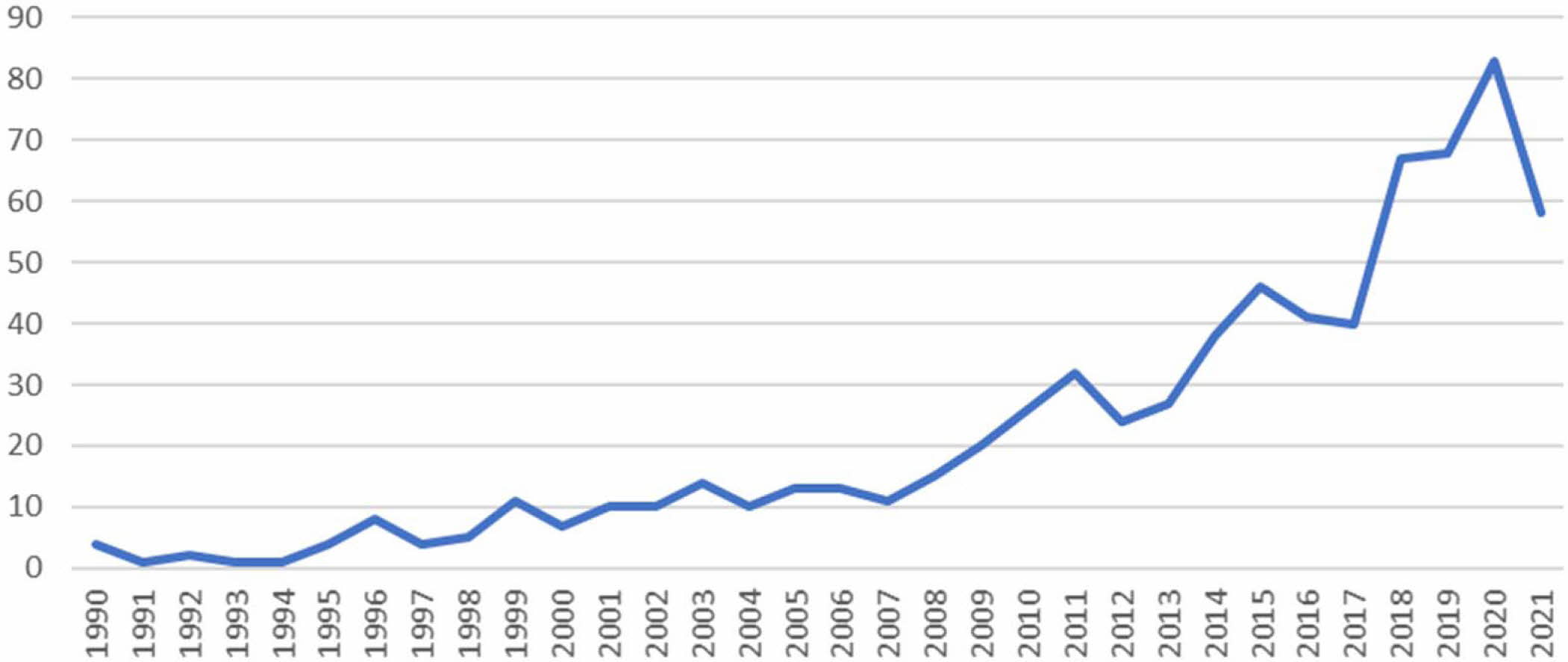
|
Fig. 1 Line graph of related publication volume of ceramics application in textiles. |
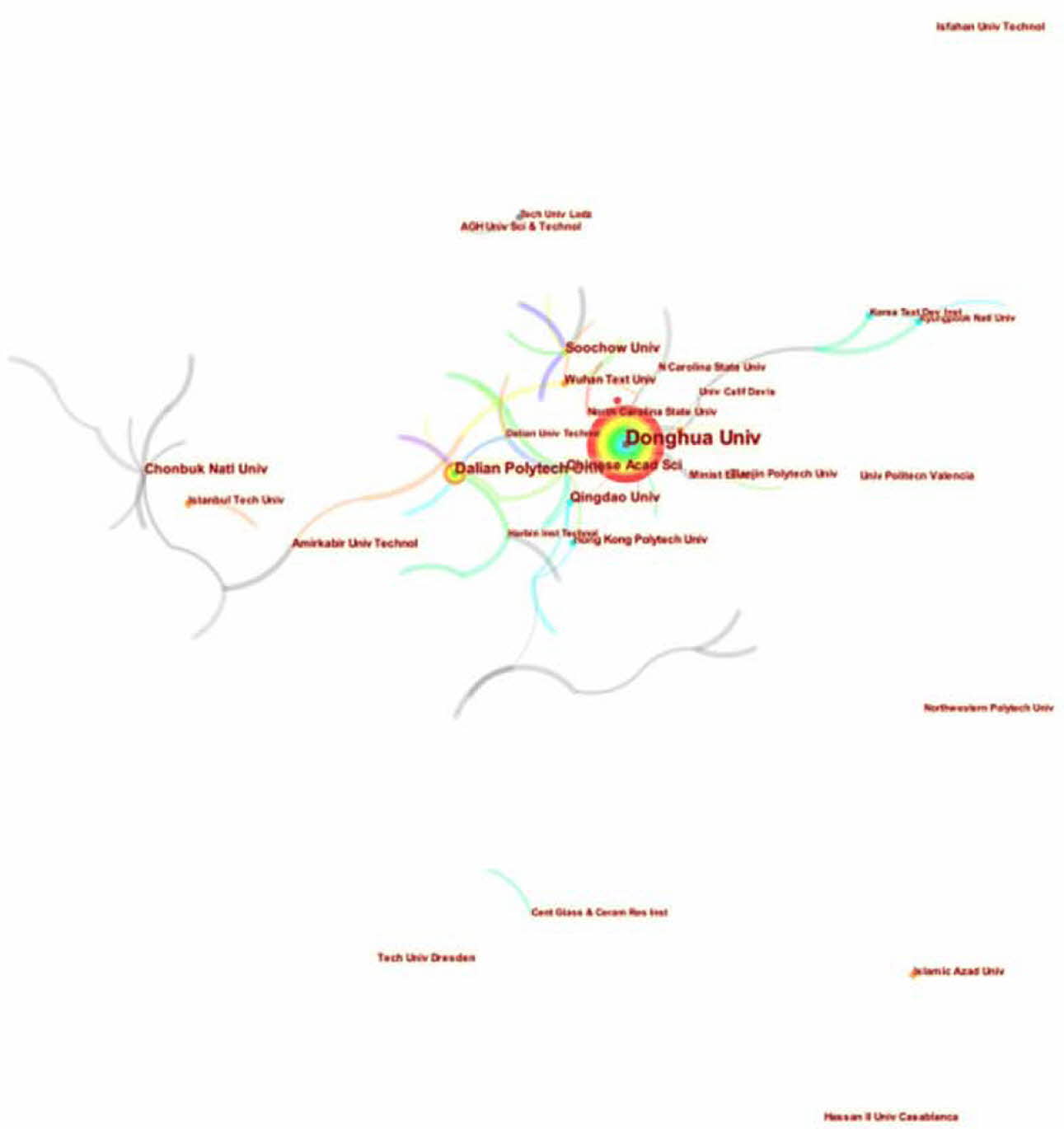
|
Fig. 2 Research collinear map of ceramic textile institutions. |
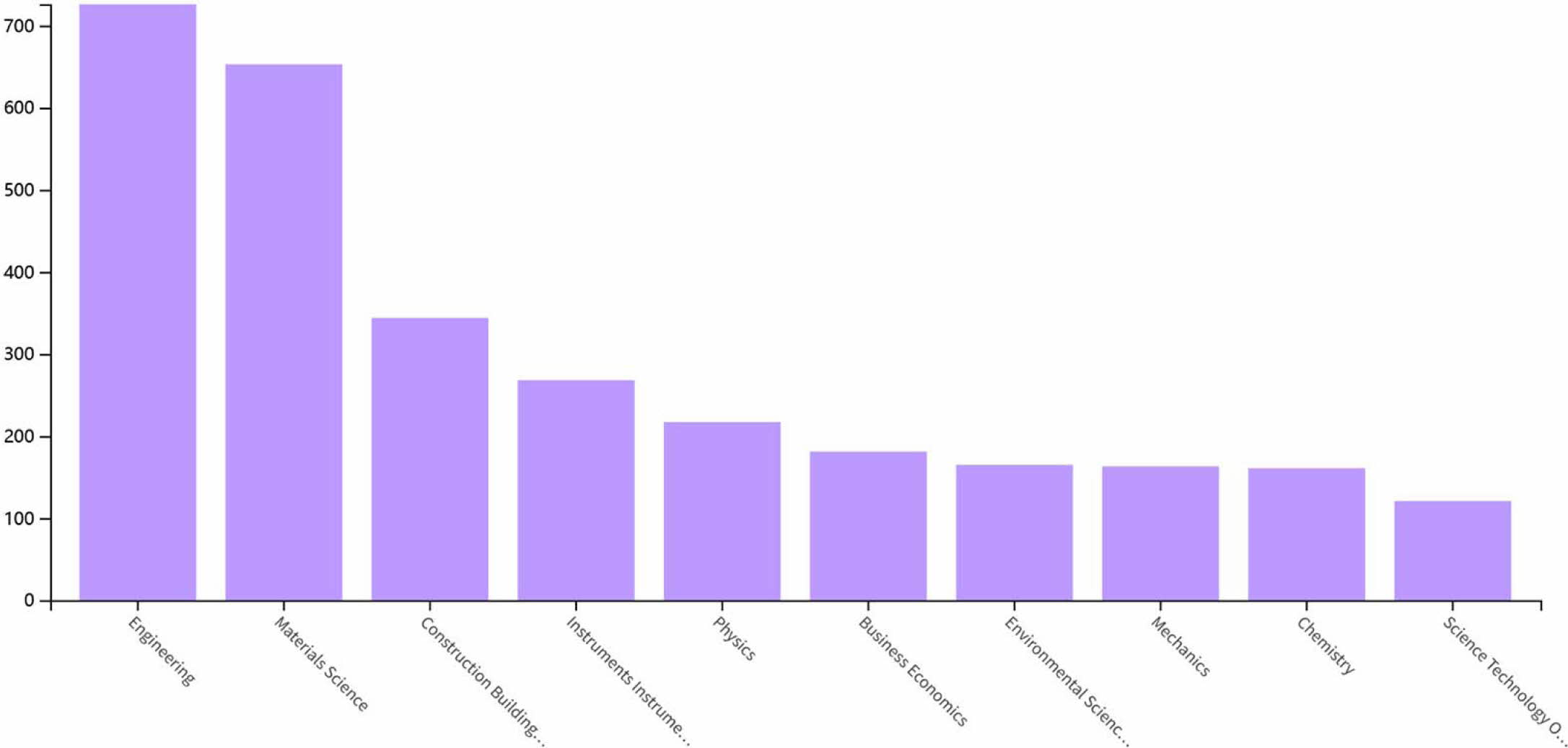
|
Fig. 3 The application of ceramics in the research direction of textiles |
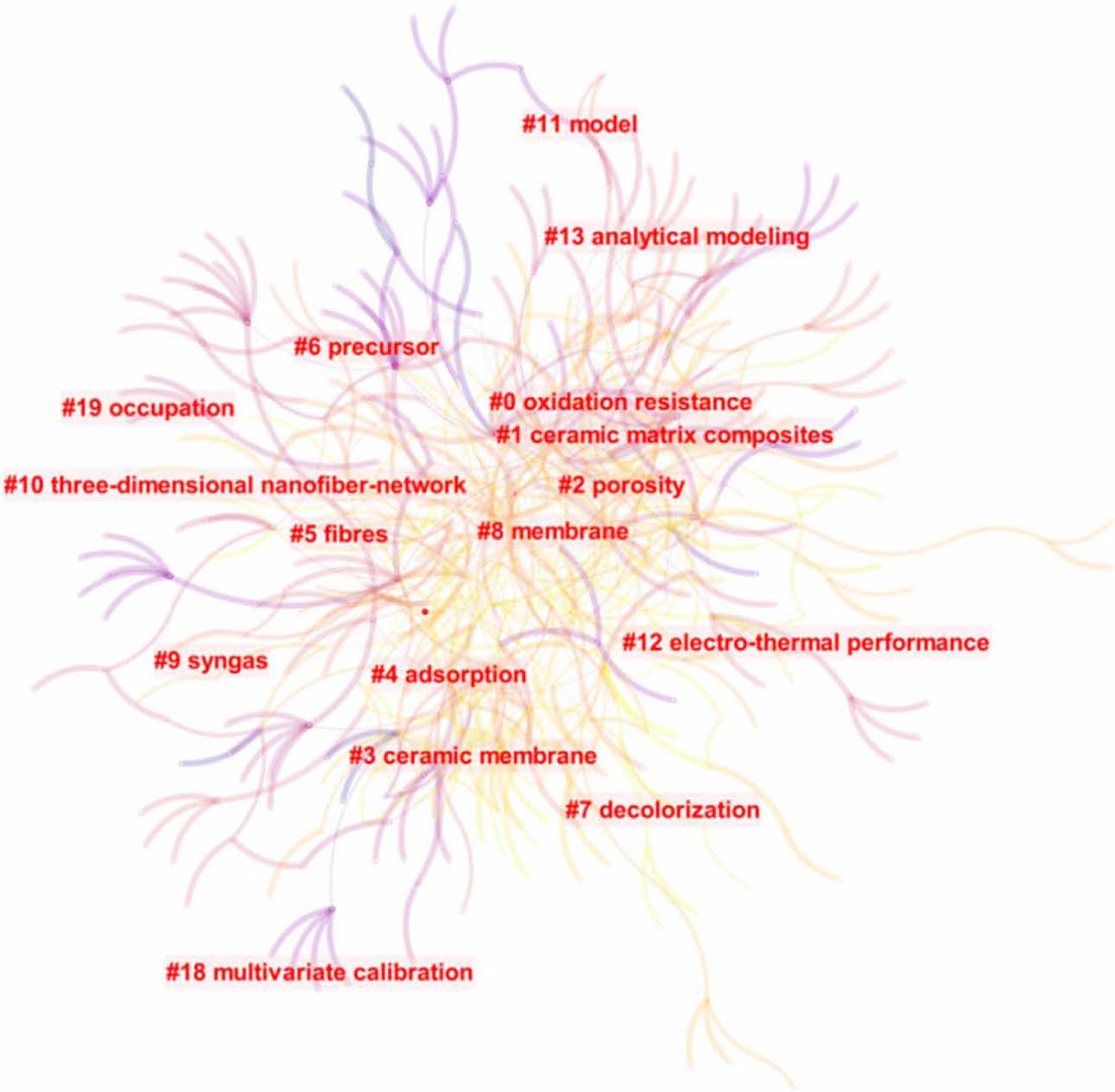
|
Fig. 4 Research keyword clustering map. |
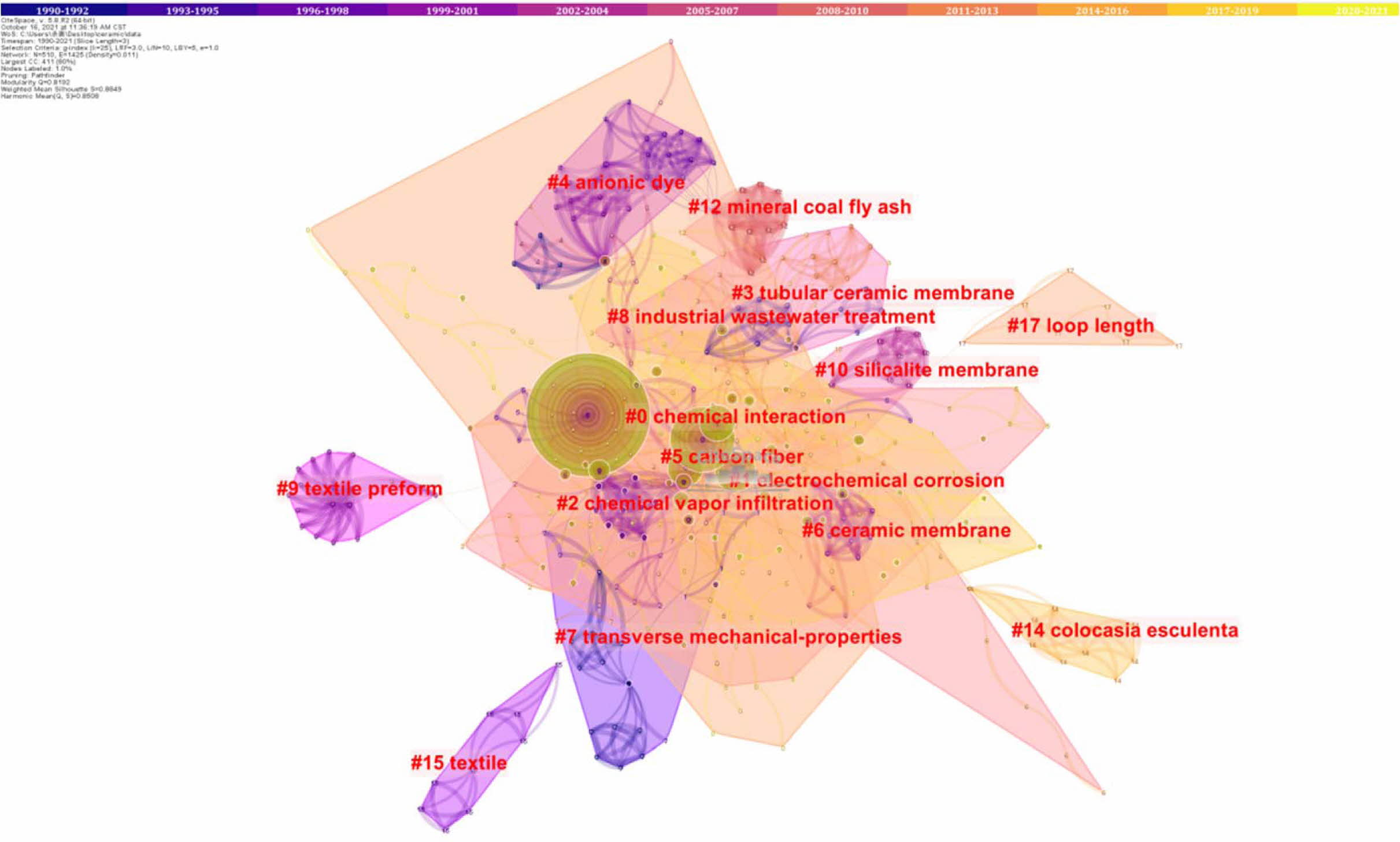
|
Fig. 5 Composite ballistic armor system of small size ceramic and fiber composite materials. |
Research path
Analysis of the keyword clustering map, draw a time zone diagram of keywords (Fig. 6). Keyword time zone diagrams can show research topics in different time periods. The dark parts of the lines in the emerging word analysis diagram represent the research focus of different periods, that is, the dynamic direction of research in this field.
It can be seen from the figure that the research on the application of ceramics in textiles has gone through three main stages of development:
(1) The initial stage (1990-2005) this stage focuses on the processing and application of ceramics in textiles, exploration of structure, and performance. Kalyvas, developed a ceramic fiber with high strength and thermal stability in 1990, Davidson, studied the fatigue and fracture of ceramic matrix composites in 1995, he studied the tensile deformation, fracture, smooth rod fatigue, and fatigue crack growth behavior of several CMC (composite materials). Clauss, B studied continuous yttria-stabilized zirconia fiber in 1996, it is believed that continuous availability has had a significant impact on the development of new high-performance ceramic fiber materials. Ceramic fibers can be used in metal substrates and components in ceramic matrix composites, high-temperature insulation materials, or microstructure applications. Chou, TW proposed the design of textile preforms for ceramic matrix composites in 1999, Schollmeyer, E developed organically modified ceramics for coating textile materials in 2002, the barrier properties of this coating are tested in aggressive environments, and evaluated by the remaining tensile strength. Using nano-metal oxide particles for inorganic, modification of organic hybrid polymer can improve scratch resistance and can improve the abrasion resistance of the coated glass fiber fabric. Kobayashi, S proposed the influence of the sample width of ceramic matrix textile composites on the flexural strength in 2005, the results show that the bending strength increases with the increase of the width, and decreases with the multiple of the unit cell size.
(2) Breakthrough stage (2006-2016) The focus of this stage of research is the extension of the special properties of ceramic textiles, and the preparation of composite materials. Park, Chung Hee studied the far-infrared emission and thermal properties of infrared thermal imaging ceramic coating fabrics in 2006, such as zirconia and magnesia, incorporated into the textile structure, in order to utilize the far-infrared radiation effect of ceramics, by activating molecular motion to uniformly heat the substrate, conduct a thermal manikin test to determine the clothing insulation and evaporation resistance of the selected warm-up suit. Cunko, R. gave an overview of research in the field of composite materials, it is believed that ceramic particles obtain materials with the following qualities in textiles: Cutting and abrasion resistance, high temperature and chemical resistance, antibacterial qualities, and special surface characteristics. At the same time, a new method of producing ceramics with coatings on fibers, yarns, and surface materials was introduced. Pay special attention to coatings made of organically modified ceramics (ormocers) or mixed inorganic-organic polymers, these polymers can be obtained by sol-gel procedures. Marshall, David B. proposed an example of a new house with ceramic composite structural components, realizes heat exchange, transpiration, fine shape, and thermal strain management functions that significantly exceed the existing technology, Jur, Jesse S proposed nano-ceramic surface modification of textiles by atomic layer deposition. Kubiliene and Diana investigated the temperature adjustment process of ceramic-containing textile materials used in cold environments and studied the thermal properties of ceramic-containing knitted textile materials.
(3) The extended application stage (20017-present) In this stage, the research on ceramics in textiles is more in-depth, related technologies and equipment are constantly updated. The absorption effect of the ceramic membrane has been paid attention to by more researches and applied to the treatment process of textile wastewater and waste gas. Breakthroughs have also been made to the original performance of ceramic textiles. For example, Yan, Jianhua adopted the domino cascade reduction method, make ceramic nanofiber textiles quickly transform from insulation to electrical conduction at room temperature, it has changed the previous oxide ceramics that were considered to be non-conductive brittle materials so that they can be used in smart products such as conductive textiles.
The future focus of ceramics application in textiles
Emergent words refer to words that appear rapidly in a certain period of time, you can judge the frontier of a research field based on it, using the mutation detection function of Citespace, draw an emergent map of keywords (Fig. 7). The picture shows that when the application of ceramics in textile-related fields has developed to a certain extent, keywords of a certain strength that appear and the course of their appearance and disappearance, these keywords are hot words in the research on the application of ceramics in textiles in different periods, the red line in the figure represents the time interval during which the keyword’s emergence occurred, Begin and End represent the start time and end time of the mutation, respectively, Strength represents the “emerging” strength of the keyword, the larger the value, the greater the impact of the keyword in the corresponding time interval of the research field. As can be seen, the keyword “mechanical behavior” is the longest and the first to emerge, from 1993 to 2013, the word with the highest emergence is “wastewater”, it may be related to the importance of ceramic membranes' ability to treat wastewater in the textile field. From an overall point of view, the emergence of keywords is consistent with the application and research phase of ceramics in the textile field. The prominent words that appeared in this stage from 1993 to 2005 include “model”, “surface”, “damage”, and “ceramic matrix composites”, and the appearance time is relatively long, and it has been the focus of research in this field since its creation. There were more prominent words in the period from 2008 to 2014 than in the previous period, there are mainly “failure”, “matrix composites”, “powder” and “particle”. Although the overall emergence intensity is not as high as the first stage, however, it shows that this stage is a period of rapid development in the ceramic textile field, various research hotspots have emerged one after another. 2017-now belongs to the third stage, many prominent words at this stage have not disappeared, emerging words such as “microstructure”, “elaboration” and “performance”, although appearing for a short time, but the emergence intensity is high, and it will continue to emerge in the future, it is an important research object of ceramics in textile applications at present and in the future.
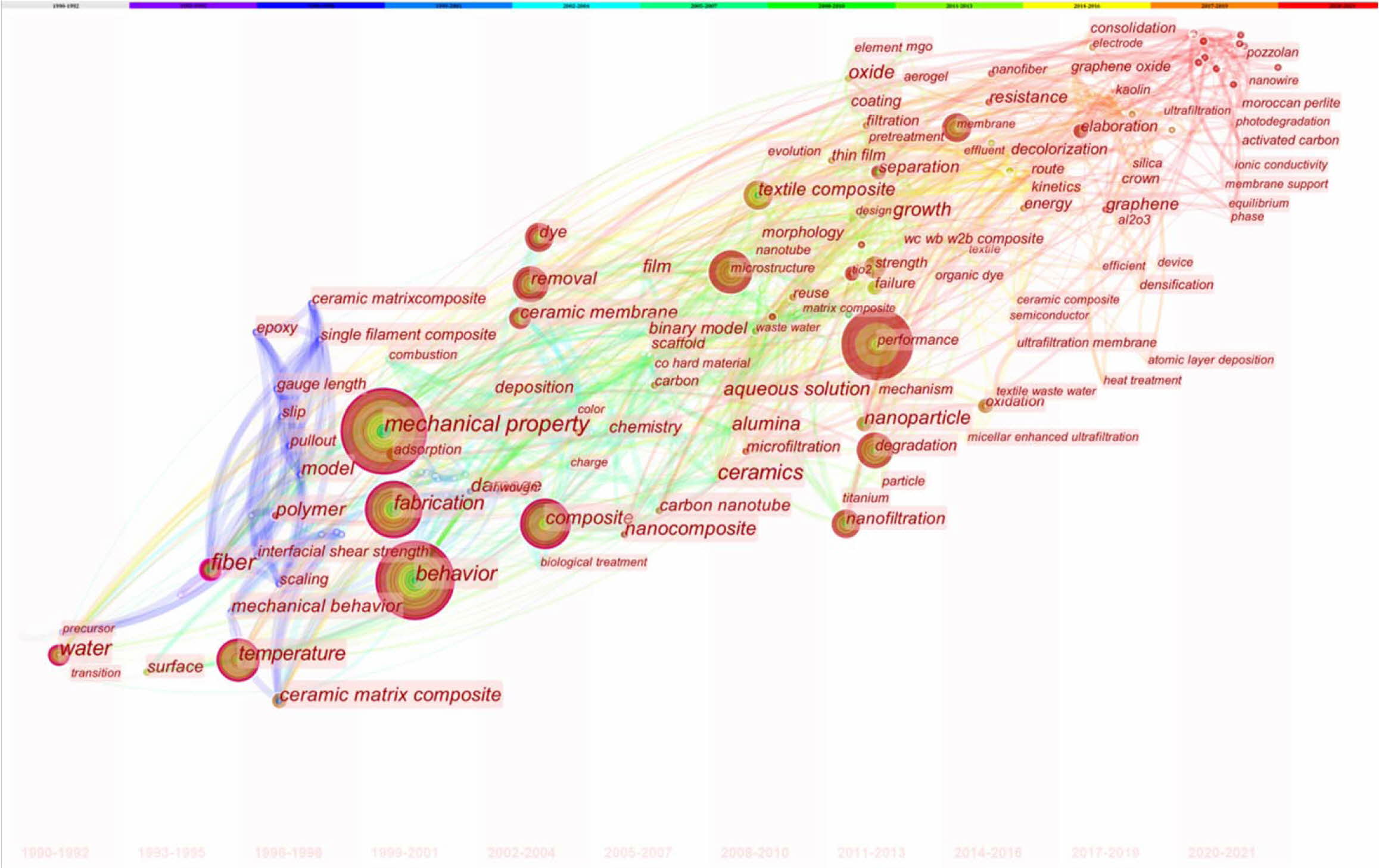
|
Fig. 6 Keyword time zone diagram |
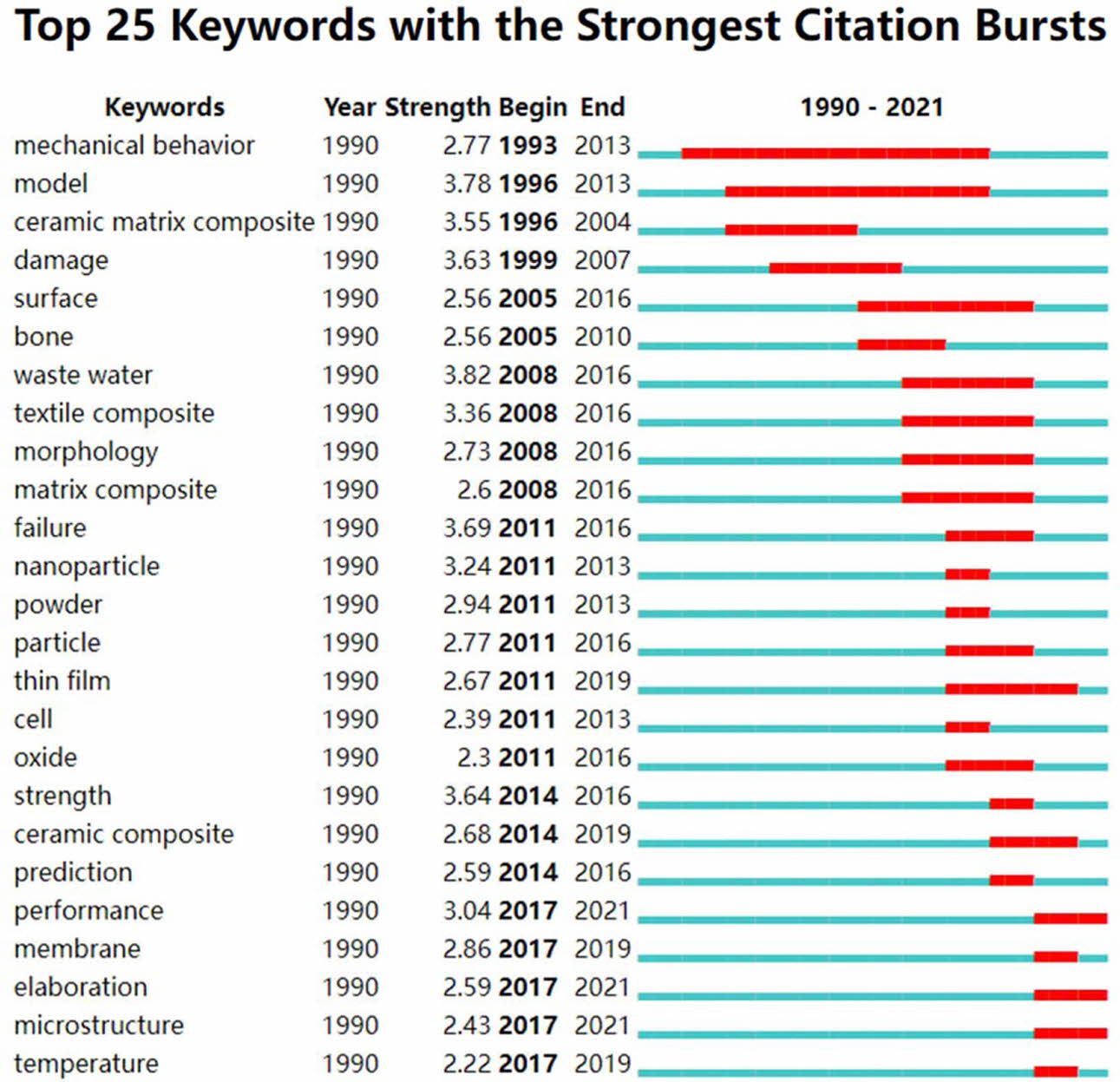
|
Fig. 7 The emergence map of keywords. |
In summary, the application research of ceramics in textiles mainly has the following characteristics: Shows continuous growth in terms of result output, the number of documents increases linearly. From the perspective of research, the research direction of this research field includes engineering, materials science, architecture, instrumentation, physics, but also the business economy, etc., which shows the characteristics of multi-disciplinary intersection, it shows that this research field has the dual characteristics of practicality and research. From the perspective of research hotspots, the research hotspots in this field are mainly anti-oxidation, ceramic matrix composite, porosity, ceramic membrane, fiber decolorization membrane, oriented nanofiber network, electrothermal performance, etc., the research stage has gone through three stages: development, breakthrough, and extension. From the early application of ceramic materials to textiles in the form of coatings or fibers, pay attention to its hard performance, to the second stage of the research on ceramic textile composite materials, the research on the thermal conductivity of ceramic textiles, etc. pays attention to its application research, in the third stage, a major change has taken place from the method to the direction of attention, related technologies and equipment are constantly updated. Ceramics have also been continuously valued in textile-related fields. In the future, the research in this field has experienced from theory to practice, the development process that constantly combines with new technologies and new ideas.
- 1. D. Medvedev, Int. J. Hydrog. Energy. 44[49] (2019) 26711-26740.
-

- 2. M. Montazerian, and E.D. Zanotto, J. Biomed. Mater. Res. A. 104[5] (2016) 1231-1249.
-

- 3. B. Farshid, G. Lalwani, and B. Sitharaman, J. Biomed. Mater. Res. A. 103 [7] (2015) 2309-2321.
-

- 4. A. de Voogt, Evol. Biol. 43[4] (2016) 498-505.
-

- 5. S. Balan, Y. Iwayama, K. Yamada, T. Toyota, T. Ohnishi, M. Toyoshima, C. Shimamoto, M. Ide, Y. Iwata, K. Suzuki, M. Kikuchi, T. Hashimoto, N. Kanahara, T. Yoshikawa, and M. Maekawa, J. Neural Transm. 122[3] (2015) 477-485.
-

- 6. V.P. Krasin, and S.I. Soyustova, High Temp. 58[3] (2020) 342-351.
-

- 7. J. Wallaschek, Arch. Appl. Mech. 86[10] (2016) 1693-1695.
-

- 8. M. Wdrychowicz, A.W. Bydaek, and B. Basiura, Arch. Foundry Eng. 18 [3] (2018) 95-100.
-

- 9. A. Kumar, S.K. Mishra, and V.K. Verma, J. Mater. Sci. Mater. Elect. 26[5] (2015) 2769-2774.
-

- 10. D. Kubiliene, A. Sankauskaite, A. Abraitiene, S. Krauledas, and R. Barauskas, Fibres Text. East. Eur. 24[3] (2016) 63-66.
-

- 11. D.M. Anderson, J.R. Fessler, M.A. Pooley, S. Seidel, M. R. Hambilm, H. M. Beckham, and J.F. Brennan, Biomed. Opt. Express. 8 [3] (2017) 1698.
-

- 12. B.N. Cox, Q.D. Yang, D.B. Marshall, and J.B. Davis, J. Propuls. Power. 21[2] (2015) 314-326.
-

- 13. M.M. Rahman, and J. Nakajima, Jpn. J. Water Treat. Biol. 51 [4] (2015) 127-140.
-

- 14. V.A. Eremeyev, A. Skrzat, and A. Vinakurava, Strength of Mater. 48 [4] (2016) 573-582.
-

- 15. I. Barrouk, S.A. Younssi, A. Kabbabi, M. Persin, A. Albizane, and S. Tahiri, J. Mater. Environ. Sci. 6[8] (2015) 2190–2197.
- 16. A.M. Nova, F.M. Tejedor, B.G. Martín, R.S. Rodríguez, and E.E. Martínez, Text. Res. J. 88[6] (2018) 696-703.
-

- 17. H.L. Zhang, L.I. Xiang-Ping, Q.I. Jian-Ying, Y.H. Chen, and J.D. Fang, Environ. Sci. 36[1] (2015) 325-332.
- 18. A. Sankauskait, V. Rubeien, D. Kubilien, A. Abraitien, and K. Dubinskait, Polym. 12[6] (2020) 1319.
 This Article
This Article
-
2022; 23(3): 312-319
Published on Jun 30, 2022
- 10.36410/jcpr.2022.23.3.312
- Received on Nov 23, 2021
- Revised on Dec 4, 2021
- Accepted on Dec 4, 2021
 Services
Services
Shared
 Correspondence to
Correspondence to
- Xiaoming Yang
-
Donghua University, Shanghai, China
Tel : +021-67792259 Fax: +021-67792259 - E-mail: 1037234058@qq.com






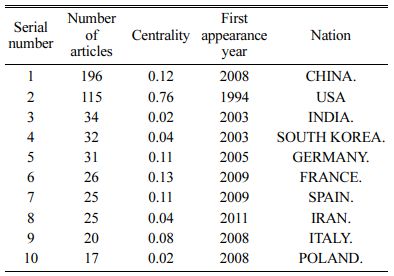
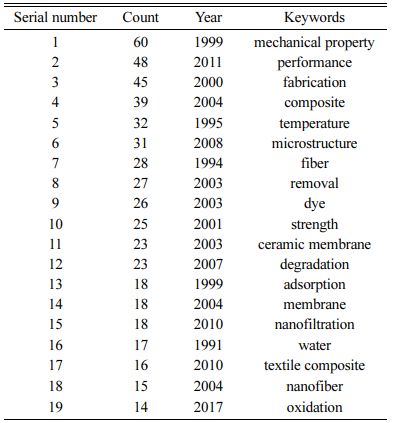
 Copyright 2019 International Orgranization for Ceramic Processing. All rights reserved.
Copyright 2019 International Orgranization for Ceramic Processing. All rights reserved.